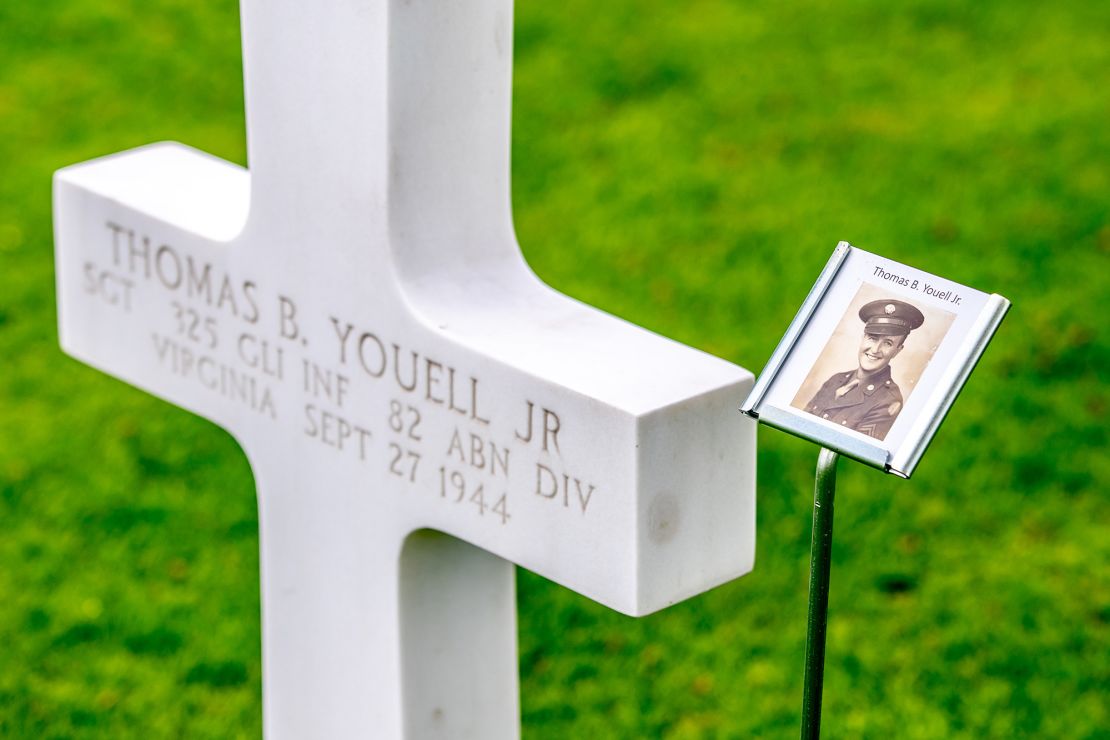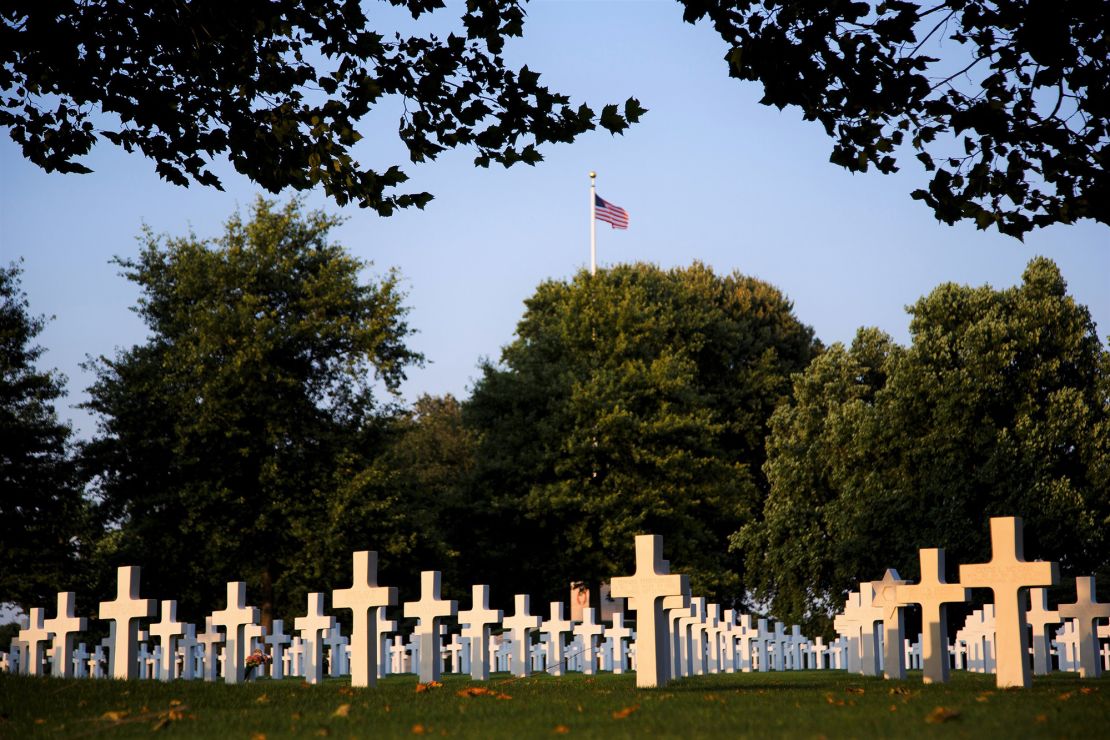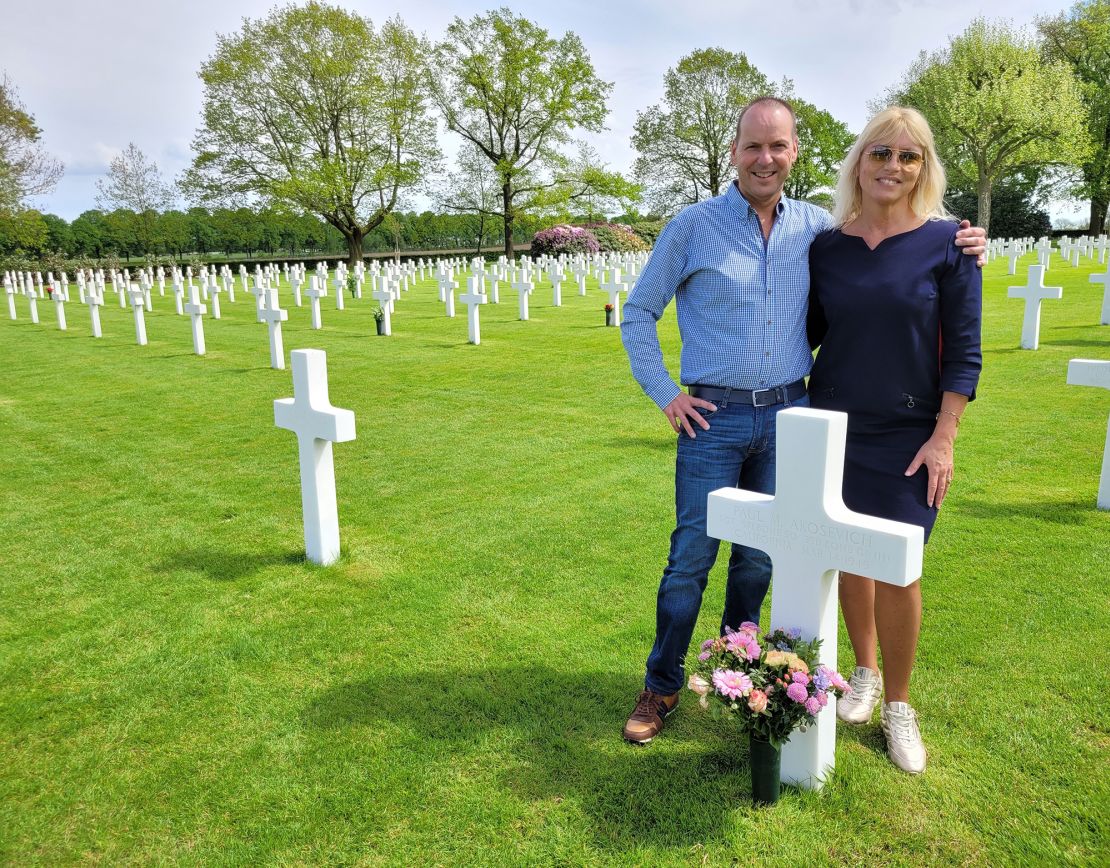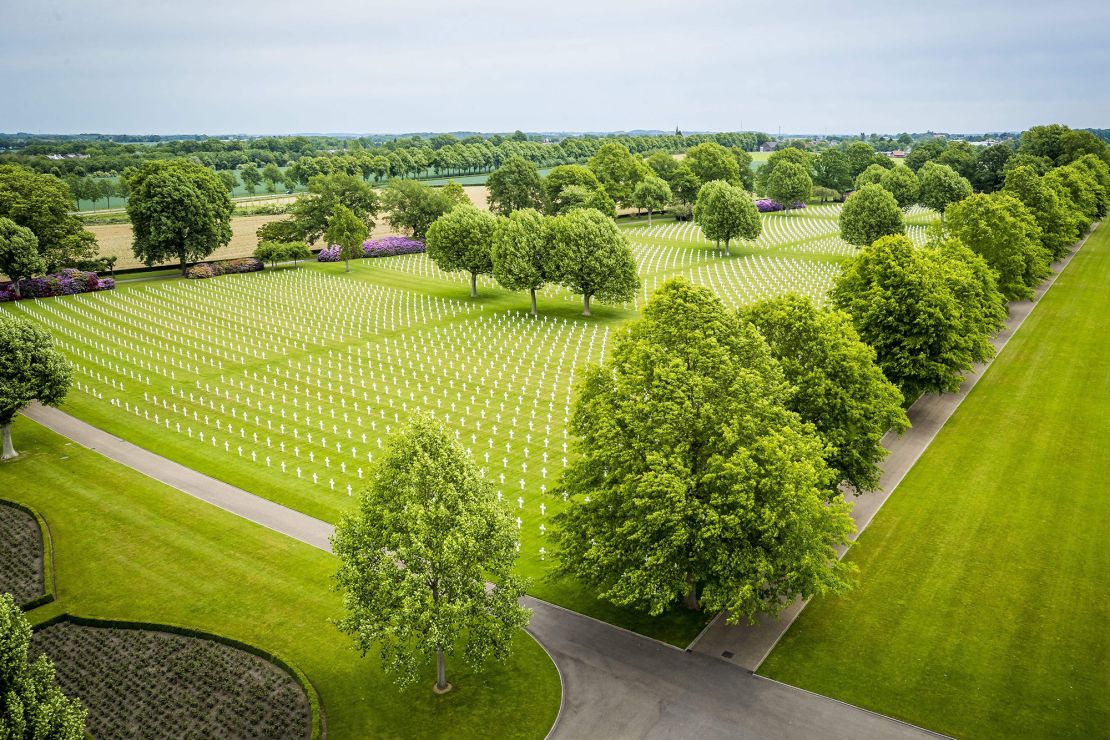Margraten, Netherlands
CNN
—
On a cold, wet March day, about 20 river cruise passengers, many from the United States, follow their Dutch tour guide through rows of rain-soaked gravestones at the Netherlands American Cemetery and Memorial.
Located on 65.5 acres in the country’s southernmost province near the town of Margraten, the Netherlands’ only American military cemetery honors about 10,000 US soldiers who died in World War II.
About 8,300 gravestones – most bearing crosses, others with a Star of David – stand in gently curved rows across the manicured lawns, their stark white marble a striking contrast to the lush, green grass. Near the cemetery’s entrance, 1,722 names are inscribed on the Wall of the Missing.
The guide is World War II expert Arie-Jan van Hees, a local resident and retired member of the Dutch military. He shares somber facts about the war during his 90-minute tour.
Its devastating human toll on Allied soldiers and on the Dutch population under German occupation, especially Dutch Jews. Harrowing details of Operation Market-Garden, the war’s largest airborne operation, which unfolded about 70 miles (113 kilometers) away. How the stories of several soldiers honored here are depicted in well-known books and series such as “Band of Brothers.”
But at Plot H, Row 6, Grave 4, the tour takes a deeply personal turn as van Hees reveals an aspect of the cemetery unknown to many first-time visitors from the United States: Every soldier has been adopted by a local family, individual or organization. The one buried here, Verl E. Miller – whose black-and-white portrait van Hees holds up – was adopted by van Hees and his family in 2005.
Along with background about his service – a glider passenger, Miller later died from a German sniper’s shot – van Hees describes Miller as a teenager growing up on a farm in Ohio, volunteering to serve in place of his newly married older brother and becoming a prolific letter writer during his service. His audience digests this information, some silent and still, others wiping their eyes.
“When I finish my tour, people say goodbye often with tears in their eyes, and they mention that so many people in the United States are not aware of the fact that there are so many American casualties abroad, but also [that there is] the adoption program at Margraten,” van Hees said in a recent interview with CNN Travel.
“And they always thank me and the Dutch people for our involvement in the remembrance of the American troops, the Greatest Generation, who are buried at the Netherlands American Cemetery.”
The cemetery is one of several across Europe with grave adoption programs. However, Margraten’s stands out as arguably the most robust and longstanding.
It dates back nearly eight decades to 1945, about a year after the original cemetery was built on a fruit orchard to accommodate the bodies of thousands of fallen US soldiers. Many were killed during airborne operations in the east of the Netherlands in fall 1944 or advances into German territory in 1945.
The war ended in Europe on May 8, 1945; by 1947, approximately 18,000 US service members were buried at Margraten (some were later repatriated to US soil). The Dutch craved a meaningful way to honor their liberators, and a grassroots movement grew as families volunteered to act as caretakers for their graves. A list was created matching soldiers and Dutch residents, with addresses and other key information handwritten or typed on index cards.
“What makes this all the more impressive is that its origins are in a small-scale, agricultural community with ordinary people: the priest, the local mayor, farmers, people through all walks of life,” said Peter Schrijvers, a WWII expert whose six books include “The Margraten Boys: How a European Village Kept America’s Liberators Alive.”
“That they managed to build up an organization in that way – collecting typewriters from whoever had one – I think is remarkable in itself.”
The movement gained further traction when a letter from the mayor of Maastricht, about eight miles from Margraten, appeared in LIFE magazine in August 1945 thanking US soldiers for their service.
Mabel Feil of Demopolis, Alabama, then wrote to the Maastricht mayor, requesting information about her late husband’s grave – which the mayor’s family ultimately adopted. That led to widespread publicity and an explosion of interest in the phenomenon, Schrijvers explained.
Since 2003, the Foundation for Adopting Graves at the American Cemetery Margraten has run the program. When the waiting list hit 1,000 names in 2021, the foundation closed it. Currently, more than 700 hopeful adopters remain, with between 30 and 60 graves becoming available every year, said foundation secretary Frans Roebroeks.
“People now on the waiting list are so eager to adopt a grave that when they get one, they do everything they can to keep it and keep it in their family,” Roebroeks said.
“They take their children to the cemetery and expect them to take over the grave when they’re older. For us, it’s very beautiful to see families with young children at the cemetery. We know that our work at the foundation is not in vain.”

Adopters pay their respects on important dates such as their soldier’s birthday and date of death, Remembrance Day and Liberation Day in the Netherlands on May 4 and 5, and US Memorial Day and Veterans Day.
In the Netherlands, September 12 also is significant, as it marks the anniversary of the liberation of the first Dutch village, Mesch, in the South-Limburg province. King Willem-Alexander and Queen Máxima will attend the official kickoff event in Mesch to mark the 80th anniversary. Other commemorative events, which several US veterans traveled to the Netherlands to join, include an annual Liberation Concert held at the cemetery since 2006.
But at the cemetery on any given day, holiday or not, people can almost always be seen placing flowers or flags next to graves or along the Wall of the Missing, sometimes with a photo of their soldier. It’s yet another reflection of the longstanding culture of commemoration in this community.
“I had one lady say to me, ‘If we forget about them, they’ll die a second time,’ ” said Schrijvers. “And I think that’s a big motivator for people, certainly the ones who still remember the war. This is the feeling they have: that if we stop doing this, if you do not convince the children and even the grandchildren and great-grandchildren to not forget, these soldiers will die a second time. And that, for many, is too much to bear.”
According to Schrijvers, several factors have contributed to the longevity and success of the adoption program. One important aspect is how the war unfolded during the fall and winter of 1944.
Starting in September, the southern part of the Netherlands was liberated by Allied troops – months before the rest of the country – after nearly five years of German occupation. US soldiers remained intertwined with Dutch communities around Margraten during major Allied airborne and ground operations into neighboring Germany, which created “exceptionally close ties between the liberated and the American liberators,” Schrijvers explained.
But when the bodies of thousands of those soldiers eventually returned to Margraten to be buried, it further instilled a sense of devotion to preserving their memories that would continue for generations among Dutch families.
“Standing in front of a grave of a young man with a full future ahead of him that abruptly ended is something that would be seared into their minds,” Schrijvers said. “It’s horrifying to contemplate, and to see that multiplied many times around you – we’re talking 18,000-plus at that time – that’s an image never to be forgotten.”
Like some Dutch survivors of the war, Roebroeks’ grandfather personally knew the soldier whose grave he adopted.
Henry W. Wolf served in the 774th Field Artillery Battalion, and Roebroeks’ grandfather allowed the soldiers to sleep on his farm; they also shared meals with the family.
When Wolf, who his grandfather “considered like his own son,” was killed, the grieving Dutchman immediately went to the cemetery to adopt Wolf’s grave, Roebroeks said. It’s now being taken care of by Roebroeks’ sister.
When van Hees’ own father was 20, his Dutch village was raided by German troops. He and other young men were taken into forced labor camps to make steel for German artillery and tanks.
“Thanks to the American 79th Lorraine Infantry Division, he was liberated shortly before the war ended, on the 8th of April, 1945,” said van Hees, whose son, Jeroen, adopted his own soldier when he was 11. “So my father owes his life to [those] American infantrymen, and I owe my life thanks to him being rescued and liberated.”
According to Roebroeks, about half of the grave adopters have made contact with their soldiers’ next of kin. Some relationships develop into deep bonds of mutual gratitude and offer a way for American families to get to know a relative they never had the chance to meet.
Such is the case for Susan Brueggemeier and Cindy Landwehr, who, along with their two other siblings, grew up in Ohio not knowing much about one of their uncles beyond that he died in WWII.

Then one day in September 2019, some 75 years after his death, Brueggemeier received an out-of-the-blue email from a cousin – strangely enough, the one named after her uncle.
He wanted to pass along information he’d just received from the Fields of Honor Foundation, an online memorial of more than 38,000 US soldiers across Europe. As Brueggemeier would soon discover, van Hees – the Dutchman whose family had adopted her uncle’s grave about 14 years prior – hoped to re-establish contact with the soldier’s next of kin.
Turns out, Brueggemeier and her husband, Bob, would be in the Netherlands within two months for a river cruise that ended in Amsterdam. A plan was made: van Hees and his wife, Nicole, would pick up the couple at the Maastricht train station and drive them to Margraten.
There, amidst the rows of white marble crosses and stars, Brueggemeier saw the final resting place of Verl Miller – her Uncle Verl – for the first time.
“It takes your breath away thinking, ‘This many people?’ ” she said. “And there are how many of these cemeteries? And these were all young people, with lives to lead.”
During the pandemic, Brueggemeier and van Hees stayed in close contact, sharing information they continued to uncover about Miller. In 2022, the Brueggemeiers returned to Margraten – this time, with Landwehr and her husband, Craig – as invited guests for three days of special events honoring their uncle.
There was a ceremony that presented Miller posthumously with the Dutch Orange Lanyard, an esteemed military award, the application for which van Hees and another Dutch war expert, Tim Hendriks, submitted to honor Miller. The visitors also toured places where their uncle lived his last days.
“They pretty much walked us through the footsteps that our uncle would have, where his glider landed, where he marched,” Landwehr said. “They even did the research to find where his foxhole was, took us there, collected soil from there for us to bring home. It was just amazing.”
Beyond keeping the memory of her uncle alive, the adoption program has had a “healing effect” on her family, Brueggemeier said: “My aunt, uncle, cousins and my siblings are drawn even closer together with Verl’s story and all that the adopters have done to honor him.”

Other adopters, meanwhile, continue searching for next of kin.
In 2005, following President George W. Bush’s visit to the cemetery, Peggy Kuijpers and her longtime partner, Maurice Claessen, adopted their own soldier, Paul Akosevich.
But the Dutch couple, who live in Margraten, have limited information about Akosevich beyond his WWII service, his home state (California) and date of death (March 14, 1945). They recently learned that he played high school football, a tidbit gleaned from a 1942 Los Angeles Times article.
They’ve registered their contact information on Akosevich’s Find A Grave page, and Claessen posts regularly on a public Facebook page for adopters about their visits to his grave. They haven’t received any outreach so far, but they remain hopeful that, one day, a relative or loved one will find them.
“We want them to know that his grave is here in Margraten, and that we adopted the grave and we take care of it,” said Claessen, who has a photo of Akosevich’s black-and-white portrait on his phone, not unlike a proud father. “He’s never alone.”
Like the adoption program and other initiatives honoring soldiers, the Netherlands American Cemetery, which is run by the American Battle Monuments Commission, is especially busy during the various commemoration events around the 80th anniversary of liberation and the war’s end in 2025.

At the $6.7 million visitor center that opened in December 2023, exhibits highlight vital military campaigns that took place in the region, with original artifacts on display such as uniforms and a wooden cross that once adorned a grave. The cemetery is an especially moving place for first-time visitors from the United States, according to superintendent Jason Bordelon.
“Because World War II didn’t take place on American soil, it’s a different feeling when you’re standing in this landscape and you are witnessing physically firsthand the environment that they were in, and you see the immensity and the power of the cemetery,” Bordelon said.
The last soldier to be buried at the cemetery is Willis Utecht, a 2nd lieutenant who was killed on October 2, 1944, near the Dutch village of Mook. Because his body could not be recovered from the battlefield, Utecht was listed as missing in action, and his name was inscribed on the Wall of the Missing.
In 1993, human remains discovered by a farmer plowing his field were eventually identified as his. On September 16, 1994, Utecht was laid to rest near the 65-foot flagpole flying the American flag.
Within weeks, his grave was adopted.











